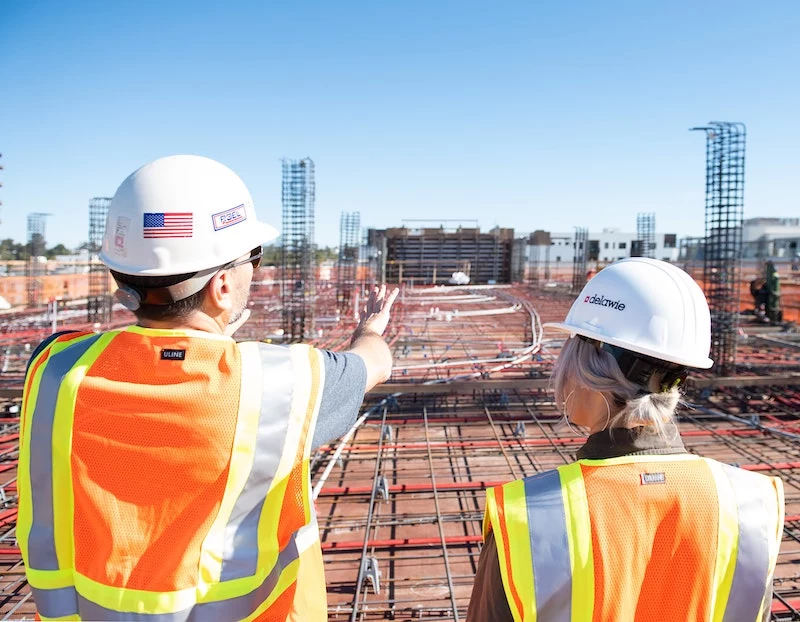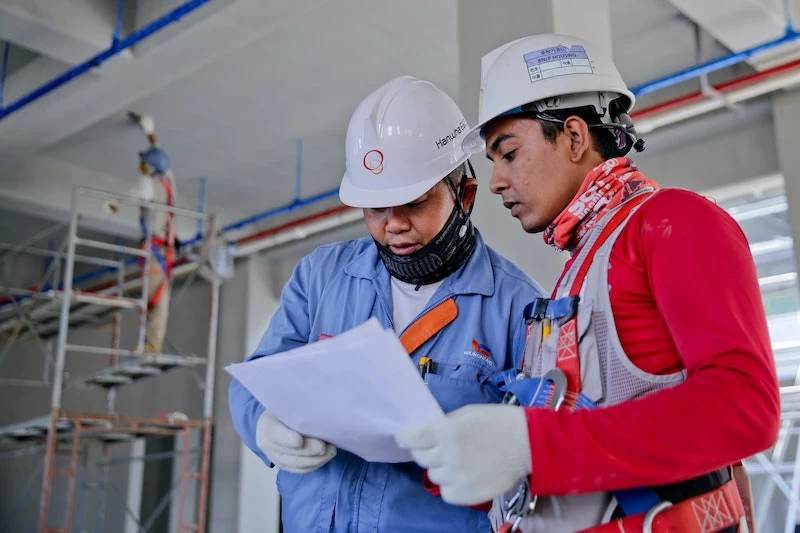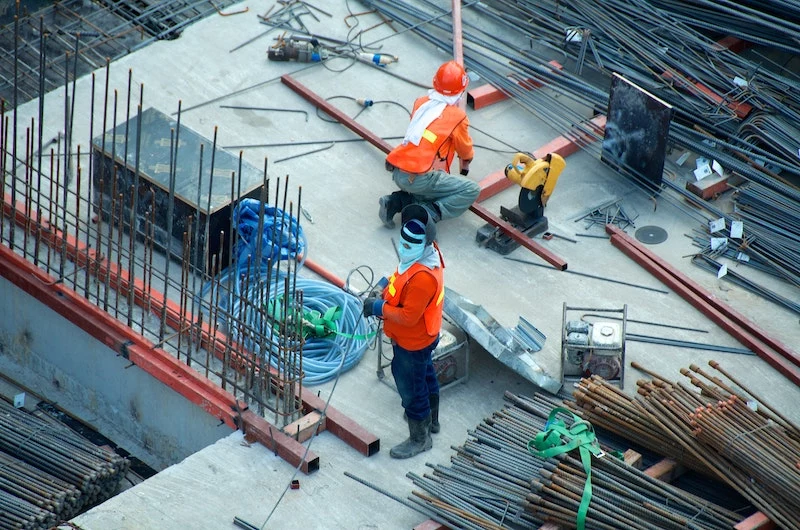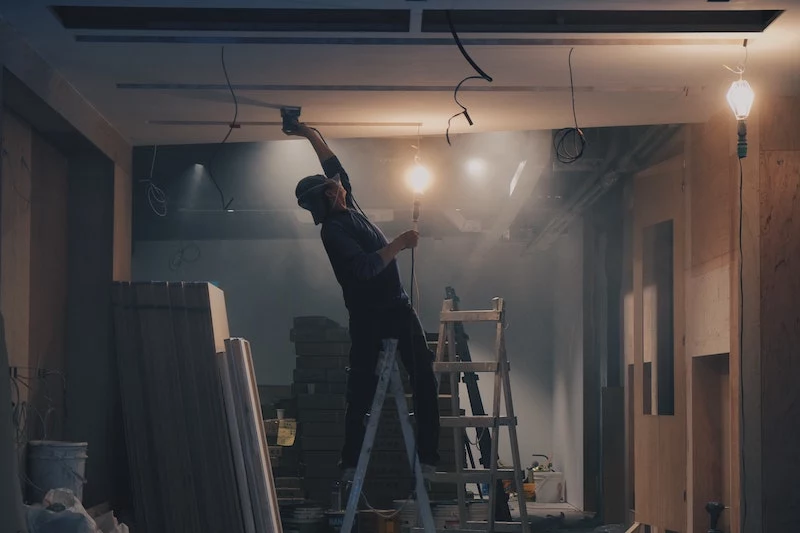Construction Loans: How to Spot the Red Flags Before They Cost You
I’ll never forget my first construction loan. On paper, it was a dream deal for a custom home. The builder had a solid reputation, the budget looked tight, and the clients were thrilled. But about six months in, reality hit. The project was dead in the water.
In this article
Turns out, the builder had lowballed the foundation bid and was trying to make up the difference by using cheap framing materials. Our inspector, thankfully, caught it. The whole thing just unraveled from there, leaving us with a half-built house and a defaulted loan. That experience was a brutal but invaluable lesson. It taught me that construction lending isn’t about shuffling papers—it’s about actively managing risk out in the real world, where things get messy.
After decades specializing in this corner of the lending world, I’ve seen projects come together like a symphony and others fail spectacularly. This isn’t some textbook theory. This is a field guide to the real risks you’ll face and how to get ahead of them, from the initial handshake to the final walk-through.

The Real Work Starts Before the Dirt Flies
Let’s be honest: most construction loan disasters are baked in before the first shovel ever breaks ground. Little weaknesses in the initial paperwork snowball into massive problems down the line. Nailing the pre-construction phase is the single most important thing you can do to protect your investment. Block out a solid half-day for a deep dive on a new project; it’s the best money you’ll never have to spend.
The Holy Trinity: Plans, Budget, and Contract
Think of these three documents as the legs of a stool. If one is off, the whole project wobbles. They absolutely have to tell the same story.
- The Plans (or Blueprints): This is the visual guide to the project, detailing everything from foundation specs to the specific type of shingles on the roof.
- The Budget: This puts a price tag on the plans. Every single line item, from concrete pours to doorknobs, needs a cost attached.
- The Contract: This is the legal glue holding the owner and contractor together, outlining the scope, payment schedule, and rules for changes.
Your job is to be the skeptic who makes sure these documents are in perfect sync. A detailed, cross-referenced review is your first and best line of defense. To make this less abstract, here’s a quick checklist of what to look for:

- Material Mismatches: Do the plans specify high-end wood windows, but the budget only allows for basic vinyl? Red flag. That’s a future argument waiting to happen.
- Timeline Conflicts: Does the contract’s payment schedule line up with the phases outlined in the budget’s draw schedule? If not, the builder’s cash flow will get squeezed.
- Scope Gaps: Does the contract’s scope of work fully cover everything shown in the plans? I once saw a contract that conveniently forgot to include the detached garage shown on the blueprints.
Seriously, scrutinize everything. I once caught a builder who submitted one budget to the borrower and a slightly different, leaner one to us. It was only a few thousand dollars’ difference, but it showed he was trying to build himself a little slush fund. We passed on that loan, and I slept great that night.
Decoding the Budget’s Hidden Stories
A builder’s budget can hide a multitude of sins. Don’t just glance at the total; you have to attack the line items. We often use industry-standard cost-estimating guides to see if the numbers are realistic for our area. A subscription to one of these services can be pricey, but you can also build your own cost database from past projects. It’s an invaluable tool.

If you see a line item for, say, framing that’s 30% below the local average, that’s a HUGE red flag. It means the builder is either clueless about their costs or fully intends to use shoddy materials or underpaid labor.
And pay close attention to what’s missing. I’ve seen budgets that conveniently “forget” things like:
- Permit fees (these can run into the thousands!)
- Utility connection charges
- Basic landscaping and irrigation
- Final site cleanup and hauling
- A contingency fund (we’ll get to this in a bit)
These aren’t optional. When they’re not in the budget, the money has to come from somewhere, and it usually comes out of the project’s quality or the builder’s already-thin profit margin.
Understanding Different Contract Risks
The type of contract used also shifts the risk around. A Fixed-Price contract sounds great because the price is locked in. But here’s the catch: if material costs spike unexpectedly, a good builder gets squeezed and a bad builder starts cutting corners. A Cost-Plus contract (where the builder bills for actual costs plus a fee) protects the builder but can expose you and the owner to massive cost overruns.

That’s why many pros prefer a hybrid: a Cost-Plus contract with a Guaranteed Maximum Price (GMP). It provides a cap on the total cost, offering a nice balance of flexibility and security. We always push for standardized industry contracts, the kind developed by major architectural associations. They’ve been tested in court and are generally fair. A custom contract drafted by a builder’s attorney? It needs a very, very careful legal review, as it’s often designed to push all the risk onto the owner.
The People Problem: A Great Project Can’t Survive a Bad Builder
Perfect documents are worthless with the wrong team. The General Contractor (GC) is the quarterback, and their experience, financial stability, and simple integrity are everything. A booming market can keep a lot of poorly run companies afloat, but when things get tight, they’re the first to go under.
So, how do you vet them? Go beyond the standard reference check. Don’t just ask, “Did they finish the job?” Ask better questions.

Here are a few I always ask:
- “How did the builder handle change orders or unexpected problems on your project?” (You’re listening for communication and fairness, not blame.)
- “Were any liens ever filed by subs or suppliers?” (This is a direct indicator of whether they pay their bills on time.)
- “How was the final punch-list process handled?” (Did they finish strong or drag their feet and argue over small details?)
But here’s the one question that cuts through all the noise: “Knowing what you know now, would you hire them again without hesitation?”
The silence before they answer tells you everything you need to know.
Oh, and a quick pro tip: Call one of their main suppliers, like the local lumberyard. Ask if the builder is on a cash-on-delivery basis or if they have a line of credit. A slow-paying contractor is a massive sign of poor cash flow management.

Financial Stability Isn’t a “Nice to Have”
You have to get the contractor’s financial statements. A credit report isn’t enough. You’re looking for one thing: working capital. As a rule of thumb, we like to see a contractor with enough cash on hand to float their own payroll and material costs for at least 45 days without a draw. If they can’t, they’re basically using the money from your project to pay off old bills from another one. It’s a house of cards just waiting for a slight breeze to knock it all down.
Managing the Money: Your Eyes on the Ground
Once construction starts, your job is to keep the loan “in balance.” This just means the money left in the loan is always enough to finish the job. Advancing more money than the value of work completed is a cardinal sin in this business.
This is why you can’t manage a construction loan from your desk. A third-party draw inspection, which typically costs between $300 and $500, is non-negotiable before you release a dime. The inspector is your expert on the ground. They’ll verify that if a builder is requesting 100% of the roofing funds, the roof is actually 100% complete and installed correctly. They also check on any materials stored on-site to make sure they’re secure and relevant to the next phase of work—not just a way for the builder to get an early cash advance.

The Most Important Piece of Paper in the File
This is a rule I never, ever break: before funding a draw, you MUST get a signed lien waiver from the General Contractor (and major subs on big draws) for the previous payment. A lien waiver is basically a receipt, a signed document stating they’ve been paid what they were owed. Without it, an unpaid subcontractor can slap a mechanic’s lien on the property, which clouds the title and can even jump ahead of your mortgage in priority. It’s a nightmare.
Early in my career, I got busy and funded a draw without waiting on the waiver from the HVAC contractor. I trusted the GC. Big mistake. Two weeks later, the GC went bankrupt. The unpaid HVAC company filed a $30,000 lien. To sell the property, the bank had to pay that bill in full. We paid for the HVAC system twice. It was a $30,000 lesson that could have been prevented by a $400 draw inspection and waiting for a single piece of paper.
Spotting Trouble Before It Explodes
Sometimes, even with the best builders, things start to feel… off. A stalled project is obvious, but the subtle signs come first. Keep an eye out for these early warning signs:
- The Slow Fade: The builder who used to answer on the first ring now takes two days to call you back.
- Excuse-a-Palooza: Suddenly, every delay is blamed on “supply chain issues” or “subcontractor problems” that never seemed to exist before.
- A Revolving Door on Site: You notice a high turnover of workers or different subcontractors on site every time you check in. This often means the GC isn’t paying their crew on time.
- A Messy Site: A well-run project is usually a clean and organized one. A sudden decline in site cleanliness can be a sign that the GC is losing control.
If you see these things, it’s time to increase your communication and site visits. Don’t wait for the project to grind to a halt.
Final Thoughts and Friendly Warnings
Managing construction risk is an active sport. It demands diligence, experience, and a healthy dose of professional skepticism. Always remember to trust, but verify. A great relationship with a builder is built on a foundation of solid processes: inspections, lien waivers, and budget reviews. Never skip the steps, even for your best clients.
And a couple of final reminders:
Heads up: This is not legal advice. The laws around contracts and liens are incredibly complex and vary by state. Always have a qualified construction law attorney in your corner.
Don’t forget insurance! Before closing, get certificates for Builder’s Risk, General Liability, and Worker’s Comp. Make sure the bank is listed as an additional insured. It’s a simple step that can save you from a world of hurt.
Yes, construction lending has more moving parts and higher risks than a standard mortgage. But it’s not a gamble. With the right diligence and discipline, you can turn a complex process into a predictable, profitable, and honestly, pretty rewarding part of your portfolio.
Inspirational Gallery
What’s the real story behind the builder’s insurance?
Don’t just accept a certificate of insurance at face value. Call the insurance agent listed on the policy. Verify that the general liability and worker’s compensation policies are active and that the coverage amounts are adequate for your project’s scale. Specifically ask if there are any exclusions for the type of work being done—for example, a policy that excludes foundation or roofing work is a massive red flag.
Nearly 40% of all construction project disputes are related to change orders and scope of work disagreements.
This statistic underscores why the change order process defined in the contract is not just boilerplate. It must be ironclad. Insist on a clause requiring all changes, no matter how small, to be documented in writing, priced out, and signed by both the owner and contractor *before* the work is performed. This prevents the dreaded
- Is the job site tidy or a chaotic mess?
- Are materials stored properly, off the ground and under cover?
- Do you see consistent evidence of safety measures, like hard hats and secure scaffolding?
- Does the quality of the visible work feel solid and professional?
Your answer to these questions during a surprise site visit tells you more about a contractor’s professionalism than any reference call.
The most overlooked document: The lien waiver. Before releasing a draw payment to the general contractor, always demand signed lien waivers from all major subcontractors and suppliers for the previous pay period. This simple piece of paper confirms they’ve been paid and prevents them from placing a mechanic’s lien on the property, which could halt the entire project and jeopardize your collateral.
Contingency Fund: This is a non-negotiable budget line item, typically 10% of total construction costs, to cover unforeseen problems. It’s the project’s safety net.
Builder’s Fee vs. Markup: A transparent builder will charge a set fee (e.g., 15% of costs) for their management services. Be wary of hidden markups on materials and labor, where costs are inflated before a percentage is even added. Demand to see original invoices.
The clarity of these financial details in the contract separates the professionals from the opportunists.
When you get a draw request, don’t just rely on the contractor’s report. Insist on getting access to their project management software. Platforms like Procore, Buildertrend, or CoConstruct provide a transparent, real-time view with daily logs and progress photos. It allows you to virtually walk the site from your desk and verify that the claimed work has actually been completed to standard.
A soil report is one of the most critical, yet frequently skimped-on, pre-construction steps. An unfavorable geotechnical survey can add tens of thousands of dollars to foundation costs.
Financing a project with a high-performance standard like Passive House or LEED certification requires a shift in underwriting. The upfront costs for superior insulation, high-performance windows (like those from Marvin or Andersen’s A-Series), and specialized HVAC systems are higher. However, these features can significantly increase the property’s final appraisal value and reduce long-term operating costs. Ensure the appraiser is experienced in valuing green buildings to properly account for this.
- It protects the budget from sudden material price spikes.
- It establishes a clear, pre-agreed process for handling cost increases.
- It prevents work stoppages due to disputes over who absorbs the cost.
The secret is a well-drafted material price escalation clause. This contractual term should specify which materials are covered (e.g., lumber, steel, concrete) and tie price adjustments to a verifiable third-party source, like the Producer Price Index (PPI).
Beyond checking their license and references, run a full background check on the builder’s business entity and its principals. Use court records to search for a history of litigation with clients or subcontractors. A pattern of lawsuits is a clear signal of potential future conflicts. This ounce of prevention is worth a pound of cure.










